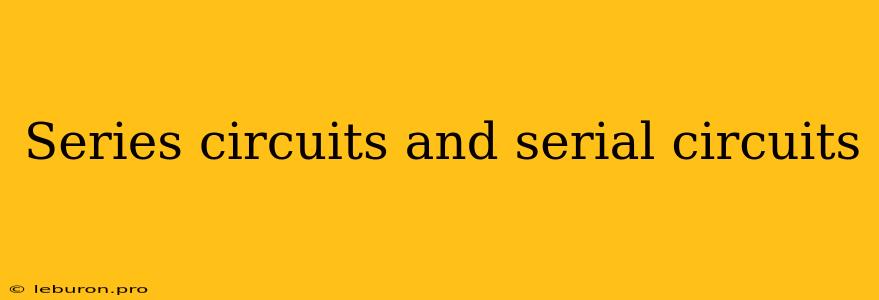Understanding the Flow: A Deep Dive into Series Circuits and Serial Circuits
In the realm of electrical circuits, understanding the flow of current is paramount. This flow can be organized in various ways, with one of the most fundamental being the series circuit. Often referred to as a serial circuit, this configuration is characterized by a single path for current to travel. This means all components, be it resistors, capacitors, or even light bulbs, are connected one after the other, forming a continuous loop. This seemingly simple arrangement offers unique properties and applications, making it crucial to grasp for anyone delving into the world of electronics.
The Fundamentals of a Series Circuit
Imagine a single lane highway. The cars (representing electrons) travel in a single file, with no branching off. This analogy aptly describes the behavior of current in a series circuit. All components share the same path, and the current must flow through each one sequentially. This creates a direct relationship between the components, influencing their behavior and overall circuit performance.
Key Characteristics of Series Circuits:
- Single Path for Current: The most defining feature of a series circuit is the single path for current flow. This ensures that the same current passes through every component in the circuit.
- Voltage Division: In a series circuit, the total voltage applied to the circuit is divided among the individual components. This means that each component "drops" a portion of the total voltage, depending on its resistance.
- Current is Constant: One of the most significant aspects of a series circuit is that the current flowing through each component remains constant. This is because there's only one path for current to flow.
- Open Circuit: If even a single component in a series circuit breaks or is removed, the entire circuit becomes an open circuit, halting current flow. This is because the single path is interrupted.
Understanding Voltage, Current, and Resistance in a Series Circuit
To truly grasp the dynamics of a series circuit, it's essential to understand the interplay between voltage, current, and resistance. Let's explore each of these elements:
Voltage: The Driving Force
Voltage, often referred to as electrical potential difference, is the driving force behind the movement of electrons. It acts like a pressure that pushes the current through the circuit. In a series circuit, the total voltage is divided across the components based on their resistance.
Current: The Flow of Charge
Current is the rate of flow of electric charge. In a series circuit, the current is constant throughout the circuit. This means that the same amount of charge passes through each component in the circuit.
Resistance: The Opposition to Flow
Resistance is the opposition to the flow of current. It's like friction in the electrical world. Every component in a series circuit possesses a specific resistance value. The total resistance of a series circuit is the sum of the individual resistances of all the components.
Ohm's Law: Connecting the Dots
The relationship between voltage, current, and resistance is beautifully summarized by Ohm's Law: Voltage (V) = Current (I) x Resistance (R). This simple equation allows us to calculate any one of these values if we know the other two.
Applications of Series Circuits
Series circuits find widespread applications in various electronic devices and systems:
- Christmas Lights: The classic string of Christmas lights exemplifies a series circuit. If one bulb burns out, the entire string goes dark because the circuit is broken.
- Fuses: Fuses are safety devices commonly used in series circuits. They have a specific resistance and are designed to melt and break the circuit if the current exceeds a certain limit, preventing damage to other components.
- Voltage Dividers: Series circuits are used to create voltage dividers, which allow us to obtain specific voltage levels from a larger voltage source. This is crucial for many electronic circuits that require precise voltage values.
Advantages and Disadvantages of Series Circuits
Like any circuit configuration, series circuits offer both advantages and disadvantages:
Advantages:
- Simple to Understand: The straightforward nature of series circuits makes them easy to analyze and troubleshoot.
- Efficient for Power Distribution: Series circuits are ideal for distributing power equally to multiple loads in applications like Christmas lights.
- Cost-Effective: Series circuits often use fewer components, leading to cost savings in some applications.
Disadvantages:
- Open Circuit Vulnerability: If any component fails, the entire circuit becomes an open circuit. This can be problematic in systems where continuous operation is critical.
- Current Limitation: The current in a series circuit is limited by the weakest component. If one component has a lower current rating, it can overheat or fail.
Conclusion
Understanding series circuits is fundamental to comprehending electrical circuits and their behavior. From their basic properties to their diverse applications, the principles governing series circuits form a cornerstone of electrical engineering. Whether you're a hobbyist exploring electronics or a professional engineer designing complex systems, a solid grasp of series circuits will serve you well in navigating the fascinating world of electricity.
